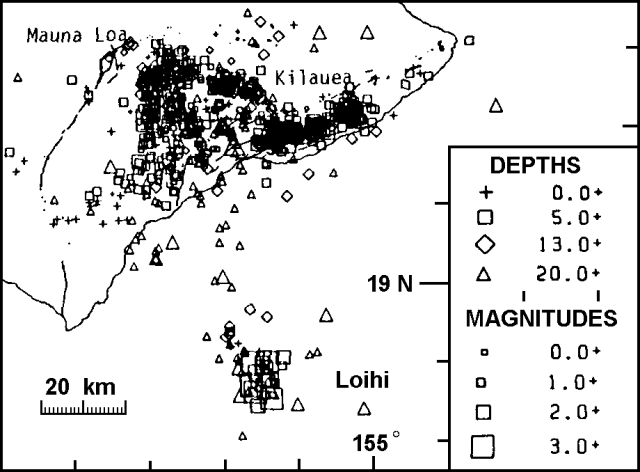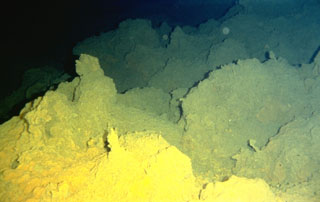Report on Kama'ehuakanaloa (United States) — September 1986
Scientific Event Alert Network Bulletin, vol. 11, no. 9 (September 1986)
Managing Editor: Lindsay McClelland.
Kama'ehuakanaloa (United States) Earthquake swarm
Please cite this report as:
Global Volcanism Program, 1986. Report on Kama'ehuakanaloa (United States) (McClelland, L., ed.). Scientific Event Alert Network Bulletin, 11:9. Smithsonian Institution. https://doi.org/10.5479/si.GVP.SEAN198609-332000
Kama'ehuakanaloa
United States
18.92°N, 155.27°W; summit elev. -975 m
All times are local (unless otherwise noted)
On 20 September, an earthquake swarm occurred in the vicinity of Lōʻihi. Seven events of M 2.8-3.9 were recorded between 1900 and 2300 before seismicity declined (figure 2).
 |
Figure 2. Hypocenters of earthquakes in the vicinity of Hawaii and Lōʻihi seamount, September 1986. Courtesy of USGS. |
Geological Summary. The Kama’ehuakanaloa seamount, previously known as Loihi, lies about 35 km off the SE coast of the island of Hawaii. This youngest volcano of the Hawaiian chain has an elongated morphology dominated by two curving rift zones extending north and south of the summit. The summit region contains a caldera about 3 x 4 km and exhibits numerous lava cones, the highest of which is about 975 m below the ocean surface. The summit platform also includes two well-defined pit craters, sediment-free glassy lava, and low-temperature hydrothermal venting. An arcuate chain of small cones on the western edge of the summit extends north and south of the pit craters and merges into the crests prominent rift zones. Seismicity indicates a magmatic system distinct from that of Kilauea. During 1996 a new pit crater formed at the summit, and lava flows were erupted. Continued volcanism is expected to eventually build a new island; time estimates for the summit to reach the ocean surface range from roughly 10,000 to 100,000 years.
Information Contacts: C. Heliker, USGS Hawaiian Volcano Observatory.

